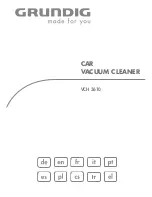
First, remove the upper protection and unpack the machine.
WARNING! Make sure the power cord is not plugged in before you start any ope-
ration.
Lay the appliance on the floor and open the tank lid as shown in Fig.1 and 2.
WARNING! Before you turn on the machine, for sucking up solids, remove the top of
the bucket (fig.3) and fill it with 0,7 litres of cold water (fig.4), paying attention that the
level corresponds to the mark printed on the separator (fig.4). The tank can be removed
for filling, if required (Fig. 5). Take off the boiler tank cap and fill the tank with about 0.9
litres water; replace the tank cap (Fig. 6). Close the tank lid and refasten it. Now you can
connect the appliance to the mains.
3. First steps with
SW3
Figure 1
Figure 2
Figure 3
Figure 4
Figure 6
Figure 5
livello H
2
O
6
21
In the present chapter, we will show you how to extend considerably your
machine’s working life thanks to an exclusive technology that allows to prevent
limescale formation in the steam boiler.
After prolonged periods of activity, limescale deposits make no longer usable the boilers
of most steam appliances found on the market. Your Multifunction Machine, thanks to an
exclusive patented technology, allows to inspect and clean the special electronic sensor
that monitors the boiler water level.
Other machines, because of limescale deposits, can no longer detect water levels; your
Multifunction Machine however, thanks to a simple operation you can carry out at home,
can be back as new. You will also be able to descale the boiler, further prolonging the
appliance efficiency.
We advise you to carry out this operation at least once a year, although the amount
of limescale forming in the boiler is very much dependent on the hardness of your
mains water. In any case, if you see a deterioration in your machine steam functions
performance, or limescale coming out of the steam accessories, that means it’s time to
descale sensor and boiler.
WARNING! We advise you against using water with hardness exceeding 30°.
Proceed as follows:
Finish off cleaning and wait for the machine to cool down completely.
WARNING! Never, for no reason whatsoever, carry out your descaling operations
when the machine is still hot! You could burn yourself. Wait at least two hours
before proceeding with any maintenance operation.
Disconnect the plug from the mains. Remove the hose from the machine, to make
operations easier.
Remove the tank lid and purification tank (Fig. 15) and empty completely.
Carefully turn the machine upside down, identifying the sensor knob (Fig. 29).
Unscrew the electronic sensor by turning the knob anticlockwise, as shown in Fig. 29.
Use the specific funnel (M) to pour approximately half a glass of vinegar (approx. 0.1
litres) into the boiler. Fasten the sensor to the boiler entrance by turning clockwise.
Tighten without forcing.
Return the appliance to its original position, and replace the tank. Close the tank lid and
refasten it (Fig. 1-6)..
Connect the appliance to the mains and turn on as usual.
Turn the boiler on by pressing the functions button (Fig. 11). Wait approximately 1 minute,
then turn the appliance off. Leave to work for approximately 12 hours, remembering to
shake the machine a little every now and then, to let the descaling solution work better.
Once the stated time has passed, unscrew the electronic sensor by turning the knob
anticlockwise (Fig. 29), take hold of the machine and empty out the boiler using a basin
or other such recipient.
After having descaled the boiler, clean the encrusted sensor with the help of a cutter
(Fig. 31), or alternatively a metal scourer. Scrape the metal part at the end of the sensor,
freeing it from the larger deposits.
Descaling the Boiler and Electronic Sensor
































